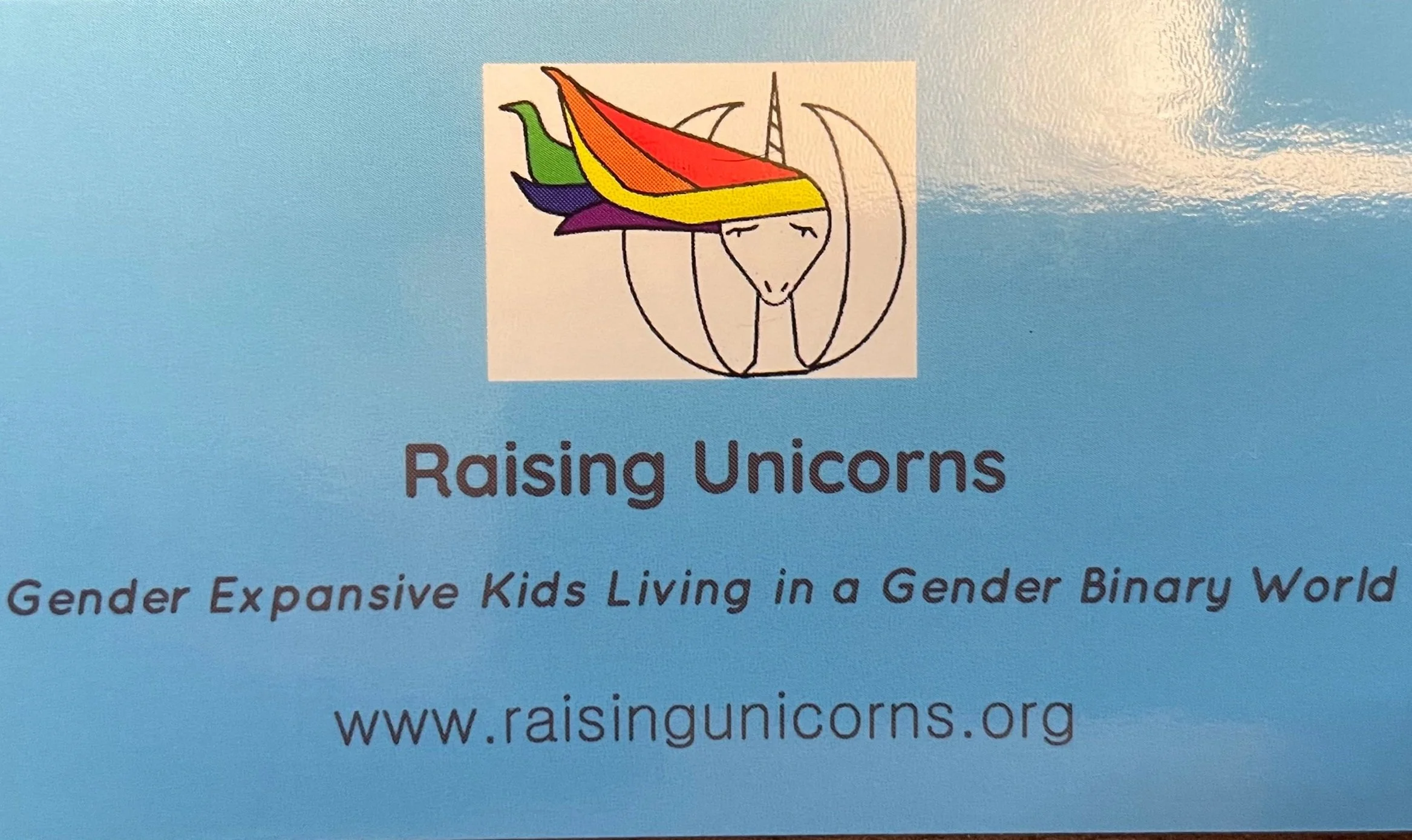Backpacks, Business Cards, & Belonging
By: Colleen K. Vesely
Isak (age almost 6)
With his pink unicorn backpack.
When my youngest child, Isak, began kindergarten earlier this fall, it was finally time to retire the hand-me-down Batman backpack that he acquired from his sister’s preschool years. During a shopping trip to Target with his dad, Isak picked out a light pink backpack donned with unicorns and rainbows and the most sparkly sequined lunch box I’d ever seen. As Isak strutted around our living room with his new pack and lunchbox, I couldn’t help but smile. I smiled not only because I love unicorns and sequins but also because in choosing this backpack and lunchbox, my cisgender male child chose himself and what he likes over conforming to others’ expectations.
On the first day of school he packed up his lunch and backpack, and wore it proudly as he walked to the bus stop. He compared packs with a new kindergarten friend who had a pink sequined unicorn backpack.
A few weeks into school, the smiles, unicorns, and rainbows faded as Isak came home from school saying he didn’t want to use his unicorn backpack anymore. When I asked why, he noted that he kept being questioned about his gender and his backpack. Isak described one exchange in which an older child asked him if he was a boy or a girl. “I’m a boy,” which opened a line of questioning from the other child regarding why Isak had a unicorn backpack if he wasn’t a girl. Isak responded without words, “I turned my head and looked out the window [of the school bus],” he told me.
As Isak told us this story during dinner, KK listened with empathy (and probably a healthy amount of rage). She emphatically reminded Isak that he can use whatever backpack he wants, and that trying to make others understand why he likes his backpack, is not his job.
About a week later, KK shared with me that she met a boy at school, Andrew, who had the same backpack as Isak. When she saw Andrew with his backpack in the hallway, KK engaged him in conversation to tell him how much she liked his unicorn backpack. KK also told Andrew that her younger brother has the same backpack and sometimes gets questioned or picked on about it. Andrew noted he gets picked on too for his pack. Ever the advocate, this prompted KK to tell Andrew about Raising Unicorns.
After school KK shared this story with me and recalled telling Andrew about the Raising Unicorns web address but wasn’t sure he would remember it to be able to tell his parents. So, she offered to write it down for him, which made me think about business cards. When I explained what a business card is to KK, she insisted we create some to share with friends and teachers at her school.
Raising Unicorns Business Card (let us know if you need a stack to share with others!)
My oldest child turned KK’s logo design into a computer graphic
We sent off our order to vistaprint, and about a week later KK had a stack of cards to give to others. We discussed how she might choose to distribute them in a discerning way since the cards cost money to print. KK shared some with her classmates, including someone whose family has a Pride sign outside of their house, as well as with two teachers—these teachers were never KK’s classroom teachers, but over the years, they each intentionally created a relationship with KK after initially connecting related to hair style choices.
One of these teachers hand wrote KK a note, thanking her for the resource, and applauding KK for being herself. While the other teacher, who was a frequent substitute teacher at the school took time to send an encouraging note to KK and me through the Contact page on the Raising Unicorns website. The more KK is affirmed by important adults in her life, the more she knows that she belongs in this world exactly as she is—-and the more supported and less alone I feel as a parent.
In addition to these amazingly affirming teachers, we also received an email from a couple of parents whose child recently shared with them that they are non-binary. These parents noted that the resources within the website were particularly helpful. It is hard for parents of gender expansive children to find others who are navigating a similar journey, and this can feel isolating. I am grateful for KK’s advocacy and insistence to share Raising Unicorns with so many people, as I love connecting with other parents who are raising their own unicorns.
Just last week KK mentioned that she gave Andrew one of the business cards, “He was so excited. He told me he couldn’t wait to get home and check out the website with his parents.” The more KK meets other children who are gender expansive, the more she knows she belongs.
Isak also carries a stack of Raising Unicorns cards around in his backpack to share with those he thinks might be interested. Last week when he gave a card to his kindergarten teacher Isak said, “I know you like to learn new things, and this will help you learn new things!” Even more importantly, we are three months into school and Isak still proudly wears his unicorn backpack every day—knowing he belongs, just as he is.
P.S. Please let us know if you’d like a stack of Raising Unicorns business cards for you or your kiddo to share with others—we are happy to send some your way. Just fill out the form on the Contact page.
The thoughtful note KK received from a teacher at her school.




